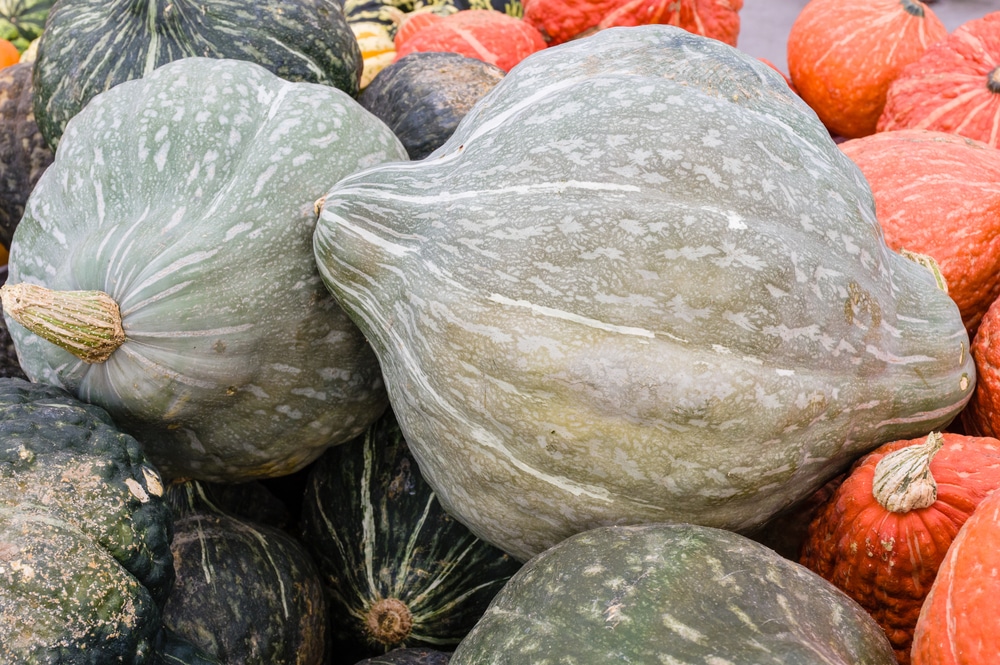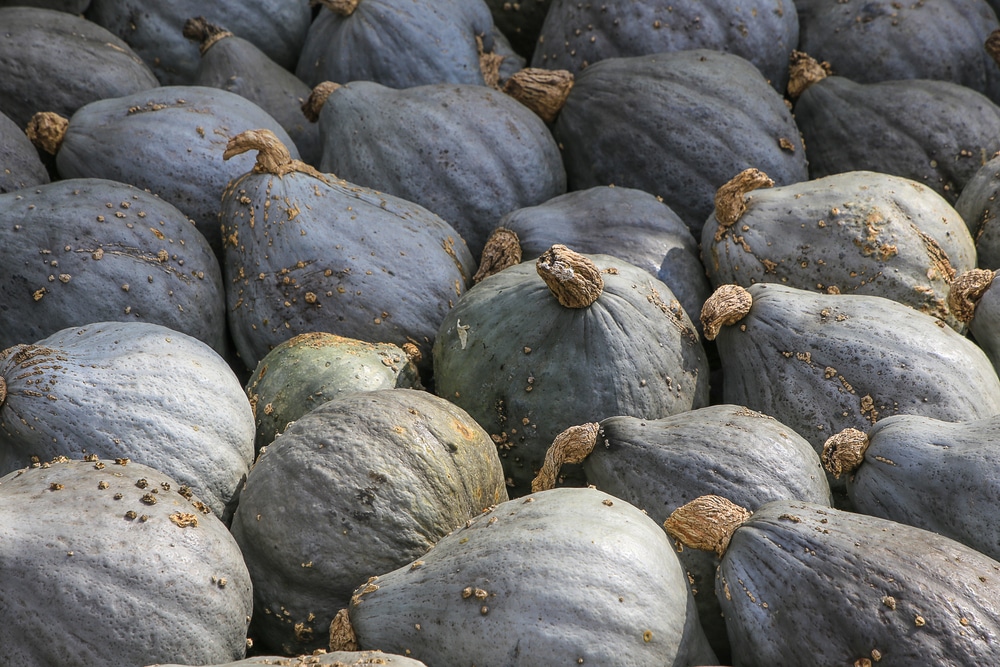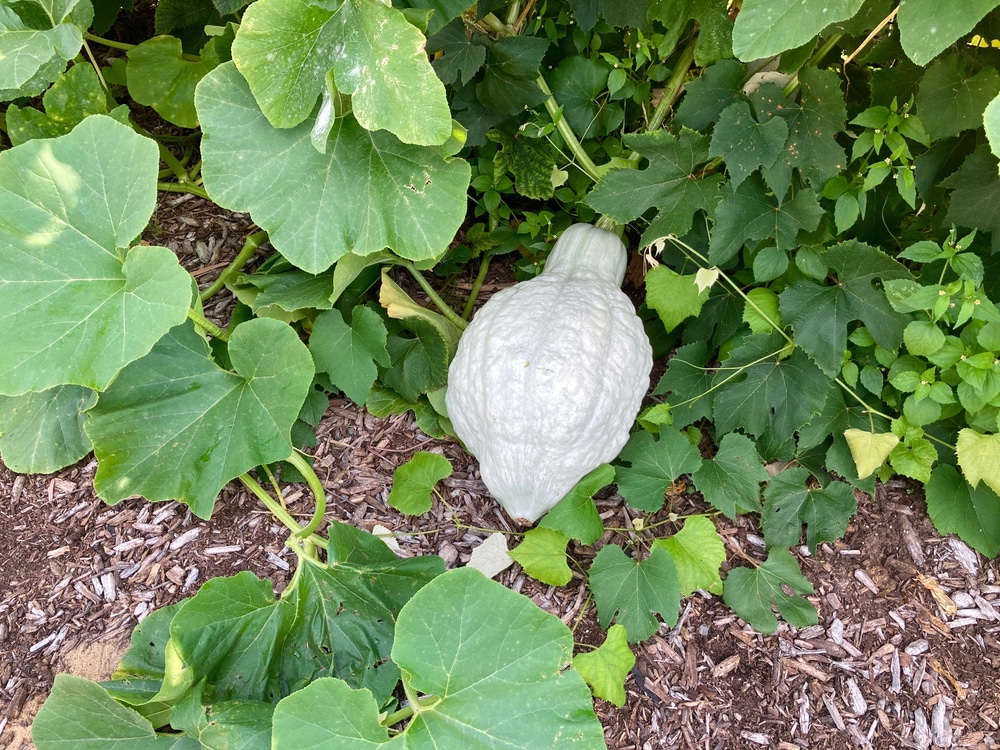The Blue Hubbard Squash is a winter heirloom plant that produces large, blue-skinned squash with an unusual shape.

| Botanical Name | Cucurbita maxima |
| Common Name | Blue Hubbard Squash |
| Plant Type | Annual |
| Flower Color | Yellow flower that turns into fruit |
| Size When Mature | 18 to 24 inches |
| Bloom Time | Summer |
| Sun Requirements | Full sun |
| USDA Hardiness Zones | 8 to 11 |
| Soil PH Range | 5.5 to 6.5 |
| Soil Type | Rich, well-drained |
| Water Needs | Medium |
| Native Area | South America |
What you Need to Know About Blue Hubbard Squash
The Blue Hubbard Squash, or Cucurbita maxima, is a popular squash variety that produces large, football-shaped fruits that can reach anywhere between 30 to 50 pounds. The skin of the fruit is blue-green, with orange meat that has a fine texture and sweet flavor.
Days to maturity and harvest are anywhere between 100 to 110 days. Blue Hubbard Squash needs a place that gets full sunlight and rich soil. Flowers appear in summer, which soon turn into giant-sized and thick-skinned fruit. Shelf life is rated at 4-6 months, and the fruit itself can be used in a variety of soups and dishes.
How to Care for the Blue Hubbard Squash
Here’s everything you need to know about growing and caring for a thriving Cucurbita maxima.
Light
To achieve maximum fruit size and quality you should reserve a spot in your yard that gets full sunlight throughout the day. The Blue Hubbard is the same as other vegetable plants- the more light you give, the healthier it is and the bigger the resulting harvest.
Water and Soil Needs
Squash plants generally need soil that has a pH of 5.5 to 6.5, and is rich in organic matter such as aged compost and mulch. The Blue Hubbard can grow in mounds, but it should be well-draining and allow water to pass through quite well.
It’s worth noting that the Blue Hubbard plant doesn’t take too kindly on being transplanted. Take extra care not to disturb the roots too much- if possible, sow directly to the ground for continuous growth and development.
Blue Hubbard plants need adequate watering to grow and produce fruits. Keep the soil constantly moist, and irrigate more when the weather turns hot. You can add an inch or two of mulch to preserve moisture and keep away pesky weeds that might pop up.
Temperature Requirements
The Blue Hubbard Squash can grow in USDA zones 8 through 11. Cucurbits are considered a tropical variety, which means they don’t take to cold weather that well. That said, you should protect your squash plants from frost with a light cover.
Fertilizer
The best fertilizer to use on a Blue Hubbard Squash is aged compost and a 5-10-10 fertilizer.
It’s recommended that you amend the growing medium with manure and compost before sowing the seeds or transplanting squash seedlings. Later on and as the Blue Hubbard variety matures, you should feed a 5-10-10 granular or liquid fertilizer that’s designed for vegetables. Make sure to follow the manufacturer’s instructions on the label for the dosage and frequency.
Continue to fertilize until harvest season so the fruits can reach their optimal size.
Common Diseases
The Blue Hubbard Squash can be affected by slugs and snails, as well as several insects such as squash bugs, cucumber beetles, and vine borers. Also, bacterial wilt and powdery mildew can infect your squash plants, causing the leaves to turn yellow and rendering them unusable.
You can prepare several countermeasures against the common cucurbit pests by installing a row cover and being vigilant. Inspect your squash plants regularly and remove the insects by hand. Remove plant debris and decaying matter the moment you see them, and avoid watering overhead to prevent the onset of fungi.
It’s recommended that you water your squash plants early in the morning to prevent powdery mildew and root rot. Don’t overcrowd and space your Blue Hubbard Squash appropriately to promote good air circulation.
Blue Hubbard Squash Propagation
The Blue Hubbard Squash can be propagated by collecting the seeds of the ripe fruits come harvest time.
Seeds may be collected on fully grown squash fruits after they’ve been consumed. You’ll have a higher chance of germination on mature squash than on young specimens. Separate the seeds from the flesh and put them on a dry surface. Allow to dry and store in a cool and dark place until the next viable season.
You can sow your Blue Hubbard Squash seeds in late spring once the soil warms up to at least 75 degrees F. Observe a spacing of 18 to 24 inches apart and an inch of depth before watering the seeds in. After about one to two weeks you should see seedlings on your starter tray or the ground.

